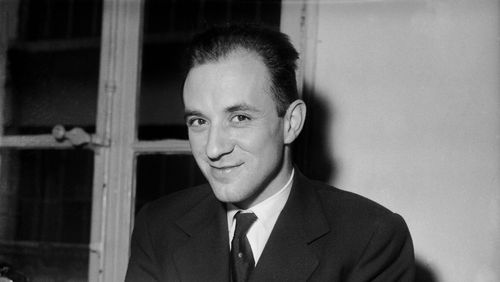
‘As I write this, the 45th President of the United States has been in office for just over two weeks. Watching the country of my birth from north of the 49th parallel where I have lived since I was three years old, it does feel as if one has wandered into the freak show tent at the Circus-at-the-End-of-the-World. Reading Michel Butor’s Mobile at this moment in American history, frames much of what we are currently watching unfold from an eerie perspective. When the French avant-garde writer was travelling the newly connected highways of America in 1959, he could not have known how very timely all the pieces of information he was gathering, fragmenting, and reconstructing into this ambitious experimental work would still seem more than half a century on. Or perhaps he did. In much of today’s rhetoric, it sounds as if there is a desire to return to some ideal USA, but if Mobile is any indication, that ideal never existed. It is a myth, like the many myths celebrated and reproduced at the grand, but very short-lived, Freedomland Amusement Park.
‘Subtitled “A novel” in the Dalkey Archives edition I read, the original subtitle offers a more accurate indication of the project at hand: Study for a Representation of the United States. Butor draws from a wide range of materials to create, or allow for the creation of, a representational framework for looking at America. He incorporates substantial excerpts from the writings of Thomas Jefferson and Benjamin Franklin, reports from the Salem witch trials, traditional and treaty records from Native American history, newspaper accounts of the 1893 World’s Fair and more, but one cannot emerge from this journey without an appreciation of an expansive land, rich in history, natural beauty, and diversity.
‘As eclectic and idiosyncratic as the nation he is attempting to capture, Mobile reads more like a poem than any manner of traditional textual prose. Even the larger textual pieces are broken up and juxtaposed against other materials including an extensive collection of place names, signs, facts, ethnic newspaper and radio programming, travel boards, catalogue descriptions, Audubon bird portraits, and Howard Johnson ice cream flavours. There is a rhythm and an awareness of pattern that binds the work together within a strict overarching structure. He follows an alphabetic rather than geographic guideline from state to state, plays up the seemingly endless recurrence of place names, and links sections across time zones.
‘Dedicated to Jackson Pollock, Mobile is often described as an unclassifiable work. It is clearly not a study in the formal sense of the word, though by standing back from the flow of fragments, a picture of the country emerges in the patchwork text. There is the sense that Butor harvested this wide range of sources and arranged them to allow the rhythm and flow of language paint a colourful portrait of the United States. It feels dynamic, natural, even when it is the intentional cleverness and humour that catches your eye. But then, it is this same playfulness that makes Mobile such a wonderfully fun read. I especially enjoyed his use of catalogue listings, as in this pairing of an advertisement for paint-by-number kits with the description of a set of panties.
‘This book is not, of course, all light and fun. There are deeply disturbing passages. Segregation is still a reality in many regions (“For whites only”), and the selections from Thomas Jefferson’s writing on the intrinsic inferiority of the black and red races are uncomfortable to read. In the light of the current concern about migrants, the ethnic and cultural diversity captured on Butor’s travels are telling (The Arabs who read “As-Sameer,” The Armenians who read Gochtnag,” The Chinese who read “China Tribune.”) Yet it is all bound together through the repetition of place names from state to state, and the famed ice cream selection at that classic highway stalwart of the era, Howard Johnsons. In the end, filtered through the lens of an outsider, Mobile succeeds in tracing a fractured songline across the heartland of America.’ — Joseph Schreiber, roughghosts
_____
Further
Michael butor @ Wikipedia
‘Mobile’ @ Dalkey Archive
Michel Butor @ goodreads
Michel Butor, the writer’s writer?
A Conversation with Michel Butor By Anna Otten
Book: The Narratives of Michel Butor: The Writer as Janus
THE SUNDAY POEM: MICHEL BUTOR TRANSLATED BY JEFFREY GROSS
In Memoriam: Michel Butor
Degrees by Michel Butor (Part 1)
Perpetuum Mobile: A Study of the Novels and Aesthetics of Michel Butor
A Source and Parallel of Michel Butor’s “Mobile”: “In the American Grain”
Michel Butor’s Mobile: Modernism, Postmodernism, and American Art
Michel Butor @ Espace Francais
L’éclectisme de Michel Butor en cinq œuvres
“For whites only” : dans les marges de Mobile (Michel Butor)
L’Armoire de Michel Butor, poète et imagier du temps qui court à la Fondation Bodmer.
MICHEL BUTOR : “POUR ÉCRIRE, J’ÉCOUTE
LES IMAGES DES ARTISTES”
_____________
Interpretation: Écran, Mobile, Butor — @ Lux
‘Since its publication in 1962, Michel Butor’s Mobile is considered to be the work that upsets the classic conception of the book, playing on a strong fragmentation and an unusual layout.
‘Today, while mobile screens are massively present in our daily lives, the forms of the book are questioned again. Mainly intended for consultation, these devices are designed to be continuously connected to the Internet. This network forms a particular context for the evolution of the texts, because a form of “textual rhizome” seems to be formed: writings are motivated by readings which in turn generate other texts, as in the case of the comments associated to an article, producing peripheral and related textual layers around it.’ — Jordane Cals
__________
Interpretation: Mobile @ Théâtre royal, Liège

‘In Michel Butor’s “Mobile”, a group of themes intertwine throughout: first impressions of the United States, jet lag, enumeration of states, history and status of Indians, advertising, etc. These different themes are combined with stories or quotes: Salem witch trials, nightmares, Lovecraft, enumeration of states, New York, physical impressions, night noises, etc.
‘In the staging of “Mobile”, the main actor moves on the Italian stage (from a, d, f, i, g, e, c, to h) at the same time as the different US states (listed in alphabetical order) on the backdrop that represents the map of the United States.
‘It is these same displacements of the principal actor that condition the interventions and the reactions of the other protagonists (actors, actresses), (5/6, 3/4, 1/2, 7/8, 11/12, 13/14 , 9/10). However, each actor, whose physical qualities and personality have been chosen to be adapted as much as possible to each of the sensitive themes of “Mobile”, has a dual role to play (hence its double numerical name: 5/6, 13/14, for example).
‘It is the passage from one position to another (from a to h) of the main actor that causes the even or odd reactions (5/3/7 or 4/2/14) of the different actors interpreting this theme or such a story of “Mobile”.
‘A series of scenographic frames is thus established, which oppose or juxtapose with the forms created by the polyphonic construction of the various topics and narrative categories of “Mobile”.
‘The map of the United States, which occupies the entire background of the main scene and of which each state is illuminated in alphabetical order, as mentioned above (groups of states beginning with a, with b, by c, etc.) disappears from time to time in favor of other images (films in cinemascope and colors, different landscapes very characteristic of the United States, fixed projection illustrating other themes, watercolors of Audubon, census of the US wildlife, clothing or household advertising, etc.). All these images are also part of the overall rhythm of the staging and are part of the versatile sound and visual structures of the performance.’ — TR
____
Extras
Michel Butor “Mobile et les USA” | Archive INA
Michel Butor – Le livre qui a changé ma vie
Michel Butor 2008
Michel Butor: Les choses nouvelles ont du mal à franchir le mur du bruit
______
Interview


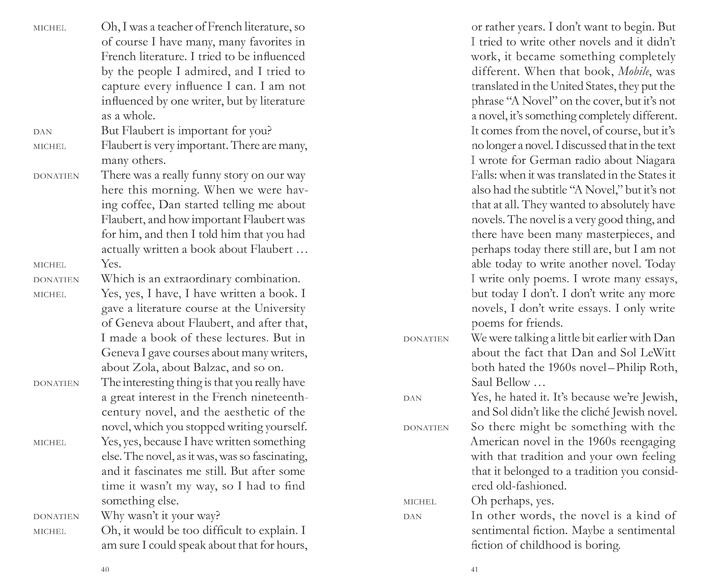

___
Book
 Michel Butor Mobile
Michel Butor Mobile
Dalkey Archive Press
‘Considered by many to be his greatest book, Michel Butor’s Mobile is the result of the six months the author spent traveling across America. The text is composed from a wide range of materials, including city names, road signs, advertising slogans, catalog listings, newspaper accounts of the 1893 World’s Fair, Native American writings, and the history of the Freedomland theme park.
‘Butor weaves bits and pieces from these diverse sources into a collage resembling an abstract painting (the book is dedicated to Jackson Pollock) or a patchwork quilt that by turns is both humorous and quite disturbing. This travelogue captures—in both a textual and visual way—the energy and contradictions of American life and history.’ — Dalkey Archive
_____
Excerpts
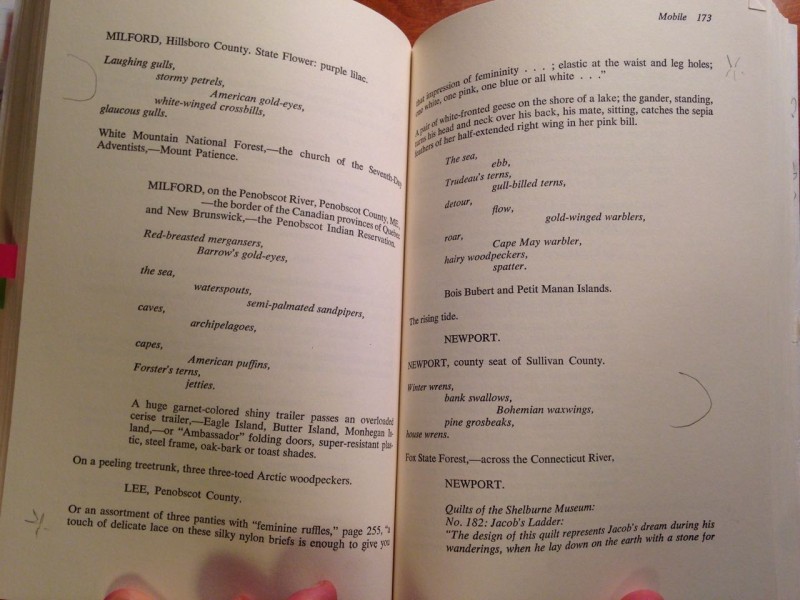
*


*
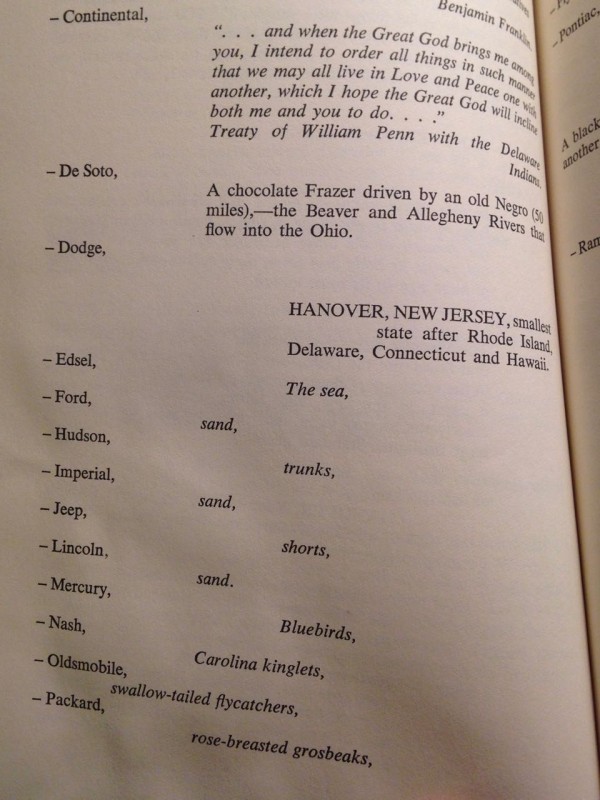
*
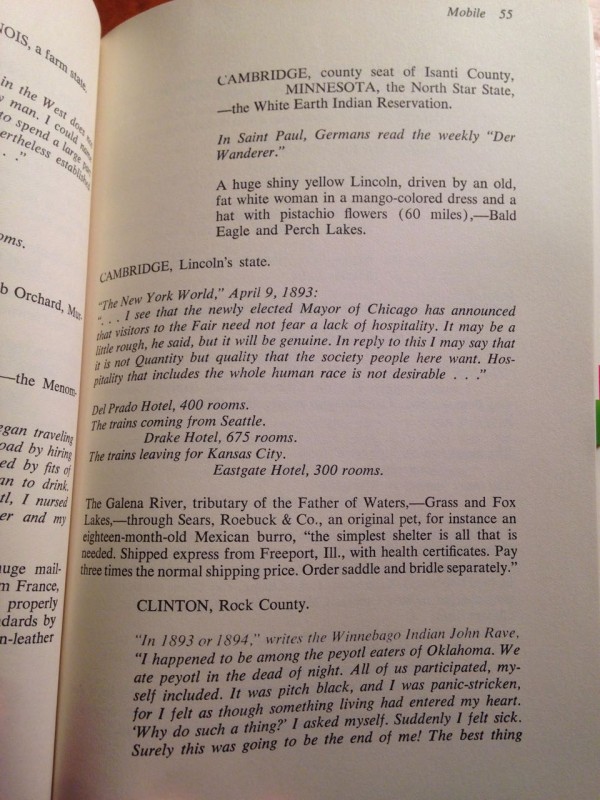
*
p.s. Hey. ** David Ehrenstein, Hi. Thanks for the good words to James. ** Sypha, Hi, James. Thank you! ** Damien Ark, Hey, man. ** yanbo, Hello, yanbo! Welcome to the insides of the place, and thanks a lot coming in. It should go without saying that you’re highly more than welcome here anytime. ** JM, Hi, Josiah. I hope everything is awesome on your end. ** Armando, Well, well, hi, pal! Long time no see indeed. Good to see you! I think all the valuable stuff in Notre Dame was saved, so I feel fairly confident in saying your favorite must have been among them. Favorite Blanchot? ‘Death Sentence’. Favorite DeLillo? Mm .. maybe ‘The Names’. Don’t really have a single favorite 2019 album yet that I can think of. Favorite 2019 novels so far … off the top of my head, I would say either Richard Chiem’s ‘King off Joy’ or Mark Doten’s ‘Trump Sky Alpha’. I’ve only read maybe two or three Joyce Carol Oates books quite a while ago, and I wasn’t very interested by any of them. You’re going to Pasadena? Wow, why? I was born there, but I grew up in next door Arcadia. Still, where I lived in Arcadia was two blocks from the border of Pasadena, so I spent a lot of my time there growing up. I prefer LA over NYC, yes. I’m extremely excited about the new Malick, and I’m hoping that, since it’s premiering at Cannes, it’ll open in France soon after. You can send me an email. Just recall that my emailing skills are very bad and slow virtually always. ** Tyler Murphy, Hi, Tyler. Yes, I got your email. I’ll try to write back to you today or tomorrow at the latest. ** Shane Christmass, Hi, Shane! Oh, thanks about the Keanu interview. Yeah, that interview, or rather his total openness in it, got him in a bit trouble back in the day. ** James Nulick, Hey, James! So happy to have the honor and opportunity. You got a bunch of support in the comments in case you don’t end up seeing them. ** Jeff J, Hi, Jeff! We exchanged texts literally 30 seconds ago if you interested to know exactly at what time I wrote this. So great to get to see you so much while you were here. You’ll be back there before you see this, no doubt, so welcome home! ** _Black_Acrylic, Benster. Hot off the risograph! Obviously the blog is hungry for that post whenever you see fit. ** Nik, Hi, pal. I’m good. Yeah, a lot of work going on, but I’m into it and staying somewhat afloat thus far. I hope you’re more floating than submerged re: yours. The Wrens … I have listened to them, but not for quite a while. In fact, I don’t even remember what their sound is, so, clearly, I need to brush up, and I will. Fantastic about the Sarajevo fellowship! Whoa, that’s amazing! Will do about the summer offer, and it’ll be great to see you here in any case. Fantastic! ** Dominik, Hey, big D! I’m so sorry to hear that you’ve been feeling low, but you sound like you’re upswinging now, no? Emotions can be very weird and unfair. Wow, about that impulsive trip to Vienna, and that’s so great about the spectacular pay-off! I’ll look to see if there are videos from the Werq the World tour. Maybe some of the magic will have transferred to the documentation. Great! And I’m obviously happy you’re liking the Blake Butler novel. Yeah, it’s amazing, right? Enjoy your valuable time with your brother. That’s sweet to hear. I’m good. Yes, still on the TV series. We’ve had a short break in the writing, but that ends tomorrow, then the grind returns. I just got an opportunity to show a new GIF novel at Art Basel in June, which is great, but that means I have to finish the new novel much faster than I had planned if I want to take the opportunity, so trying to get that finished that has become heavy work. And PGL comes out in France soon, and doing press and stuff for that is taking over. Lots going on, yes. Parc Asterix was a blast. It was very, very crowded, and the lines were massive, so we didn’t get to go on anywhere near as many rides as we’d hoped, but it was still big fun. Lots of love back to you, my friend! It’s so good to see you! ** Steve Erickson, Thanks! My ‘prayer’ is that the JT Leroy movie is a massive flop and disappears as quickly and with as little publicity as possible. ** Misanthrope, Hey, G. Surprised to see that wild old thing again? Still looks good, I thought. Ouch, your back, and ouch/eek, your phone. You mobile (without a mobile)? ** Nick Toti, Now that’s a wild occurrence right there. Whoa! I’ll go find it in the post and get all attentive. The post was originally launched in two parts on December 12th and 18th, 2015. So a few years after you made it. That’s wild. You good? ** Okay. I’ve been trying to make a post about this great Michel Butor book off and on for years, but somebody finally uploaded some examples of its interior online recently, and that was the cue to go ahead and put my spotlight on it. Great book. Check out its evidence. See you tomorrow.




 Now available in North America
Now available in North America 
I’ve always been crazy about “Mobile” it is indeed a masterpiece. It’s dedication to Jackson Pollack is key to its effect as it’s an “Action Text” like an “Action Painting” As such it has much in common with the writings of J.G. Ballard (especially “Crash”) and the paintings of Richard Hamilton
Oh and before I forget WELCOME TO THE RAPTURE! (It’s supposed to arrive today you know)
“Mobile” is a masterpiece comparable to the best of J.G. Ballard (fiction and non) and the paintings of Richard Hamilton
I’m glad there’s a date for the PERMANENT GREEN LIGHT screenings in New York. I saw it on my laptop and feel like I missed a lot. I’m planning to go on May 2nd. It’s a shame that those will be your only theatrical screenings before it goes to VOD/Blu/DVD.
How do you think the yellow vests protests are developing? I saw Jeff’s photos of the recent burned cars and rising smoke and while I’m not surprised that the huge outpouring of money to fix Notre Dame led to massive class resentment, is this leading towards demands that will be expressed in support for political candidates or laws? At the time of Occupy Wall Street’s peak of popularity, it was frequently criticized for expressing anger without a direct platform, but it’s now clear that was the beginning of the normalization of socialist ideas and a sense that millennials had been seriously screwed in the US and contributed to a path that’s led to the popularity of Medicare For All and serious reform about college debt.
Hi Dennis,
Oh wow. The original post was from late 2015? I’m surprised I missed it when it originally ran. Regardless, it was a pleasant surprise to see that something I made was found (and presumably enjoyed) by someone I don’t personally know.
I’m good. My Megan Boyle movie (25+ hours documenting her marathon reading of LIVEBLOG) is almost almost almost done. I basically just need to export a version that’s small enough to upload to Vimeo. With a project this long, everything takes forever. Exporting videos can take a full day, and if anything goes even slightly wrong I have to start over. Finishing has been something of a moving target.
Other than that, I’ve got a bunch of other projects in various stages of completion. One of them is a DVD of our mutual friend Bene de Alessi’s short films, which should be available later this year. Anyway, lots of things to distract myself from the tedium of wage slavery that occupies the other 40 hours of my week!
I trust things are going well for you. I’m looking forward to the next GIF novel. Talk soon!
Oh man I love this so much. John Trefry who runs Inside the Castle loves Butor. I wish I’d been familiar with this prior to finishing my nonfiction book. This rules so much. Thanks Dennis!